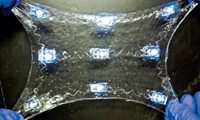Advertisement
Grab your lab coat. Let's get started
Welcome!
Welcome!
Create an account below to get 6 C&EN articles per month, receive newsletters and more - all free.
It seems this is your first time logging in online. Please enter the following information to continue.
As an ACS member you automatically get access to this site. All we need is few more details to create your reading experience.
Not you? Sign in with a different account.
Not you? Sign in with a different account.
ERROR 1
ERROR 1
ERROR 2
ERROR 2
ERROR 2
ERROR 2
ERROR 2
Password and Confirm password must match.
If you have an ACS member number, please enter it here so we can link this account to your membership. (optional)
ERROR 2
ACS values your privacy. By submitting your information, you are gaining access to C&EN and subscribing to our weekly newsletter. We use the information you provide to make your reading experience better, and we will never sell your data to third party members.
Materials
Stretchy Ionogels For Soft Machines
by Journal News and Community
May 19, 2014
| A version of this story appeared in
Volume 92, Issue 20
Some engineers want to ditch hard metals and plastics and instead use flexible materials to make wearable sensors or to build robots that can deform to squeeze through tight spaces. An international research team has now demonstrated that ionogels—polymeric gels that contain an ionic liquid—could serve as transparent, stretchable conductors in such devices (ACS Appl. Mater. Interfaces 2014, DOI: 10.1021/am501130t). Zhigang Suo of Harvard University; Yong Mei Chen of Xi’an Jiaotong University, in China; and colleagues made an ionogel using acrylic acid, poly(ethylene glycol) diacrylate, and ketoglutaric acid in the ionic liquid 1-ethyl-3-methylimidazolium ethylsulfate. To test the ionogel’s properties, the team built a simple actuator based on an elastic polymer that changes shape in response to an applied voltage. The researchers stretched the polymer over a plastic frame and then attached circular sheets of ionogel to the top and bottom of the polymer. When they applied a voltage, the ionogel stretched with the polymer up to 4.6 times its original length without breaking. The sturdy ionogel could also stretch and relax for at least 1 million cycles without failing.





Join the conversation
Contact the reporter
Submit a Letter to the Editor for publication
Engage with us on Twitter